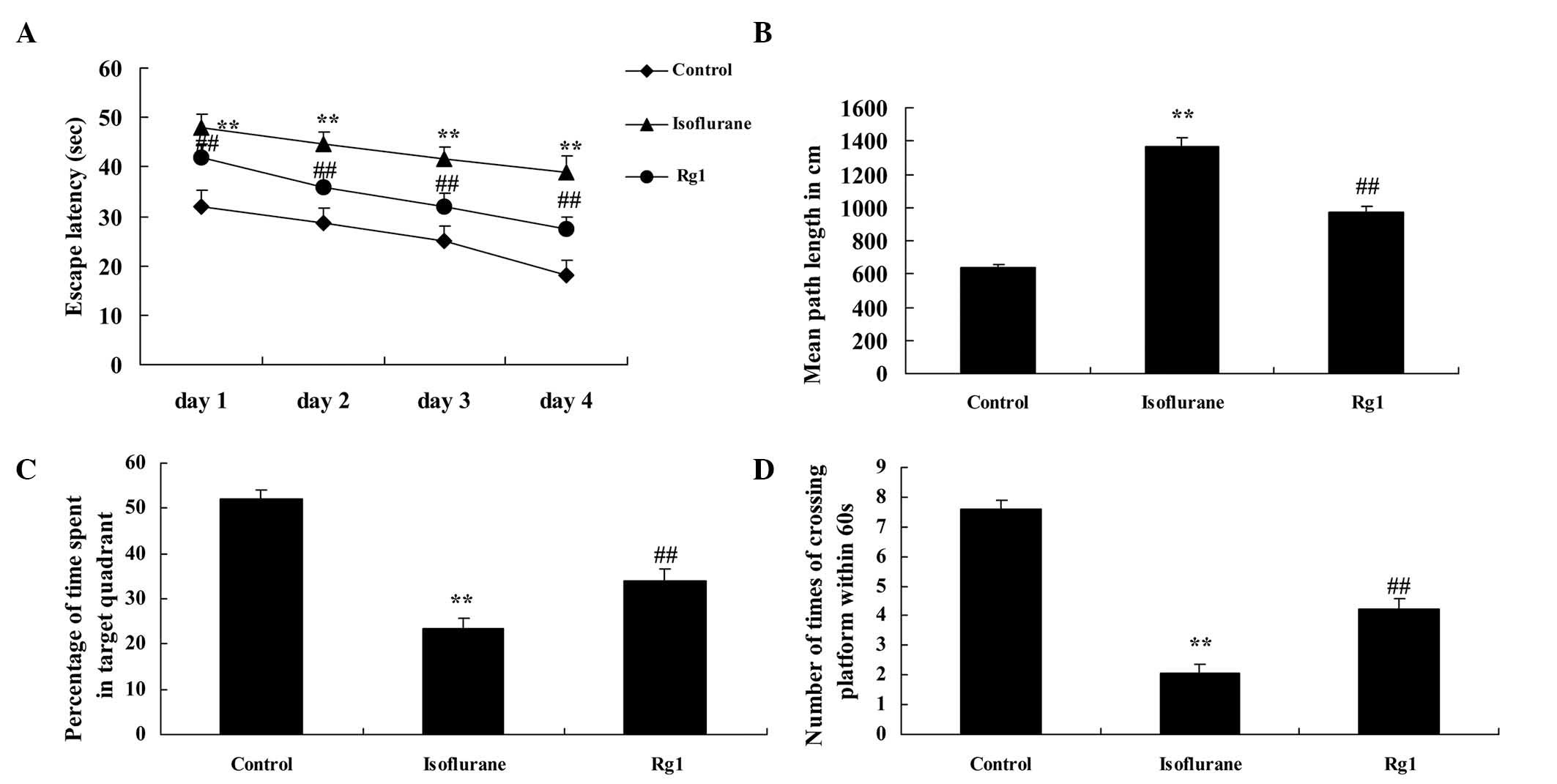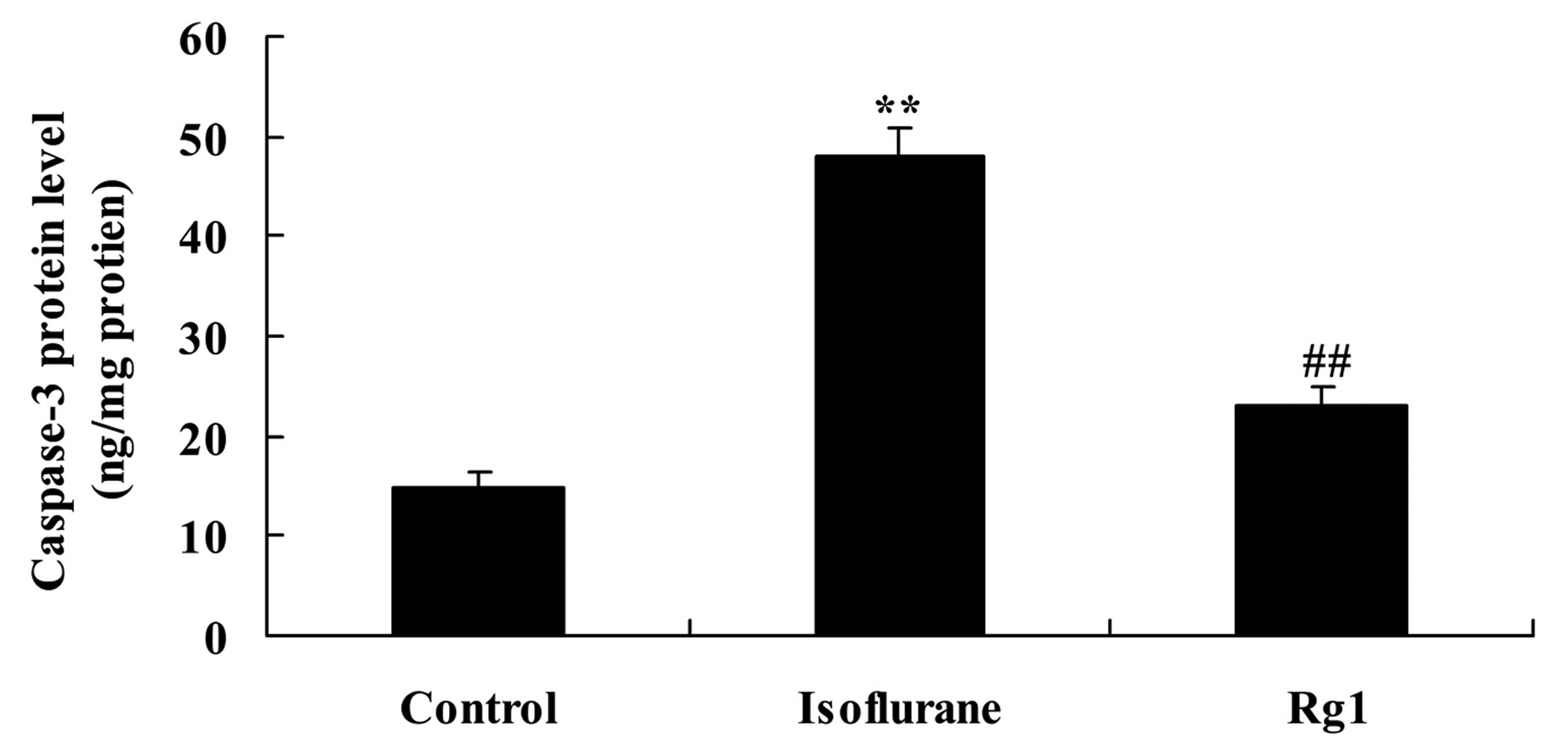|
1
|
Lin D and Zuo Z: Isoflurane induces
hippocampal cell injury and cognitive impairments in adult rats.
Neuropharmacology. 61:1354–1359. 2011. View Article : Google Scholar : PubMed/NCBI
|
|
2
|
Spitzer WJ and Davidson KW: Future trends
in health and health care: Implications for social work practice in
an aging society. Soc Work Health Care. 52:959–986. 2013.
View Article : Google Scholar : PubMed/NCBI
|
|
3
|
Tachibana S, Hayase T, Osuda M, Kazuma S
and Yamakage M: Recovery of postoperative cognitive function in
elderly patients after a long duration of desflurane anesthesia: A
pilot study. J Anesth. 29:627–630. 2015. View Article : Google Scholar : PubMed/NCBI
|
|
4
|
Wang W, Wang Y, Wu H, Lei L, Xu S, Shen X,
Guo X, Shen R, Xia X, Liu Y and Wang F: Postoperative cognitive
dysfunction: Current developments in mechanism and prevention. Med
Sci Monit. 20:1908–1912. 2014. View Article : Google Scholar : PubMed/NCBI
|
|
5
|
Liu J, Wang P, Zhang X, Zhang W and Gu G:
Effects of different concentration and duration time of isoflurane
on acute and long-term neurocognitive function of young adult
C57BL/6 mouse. Int J Clin Exp Pathol. 7:5828–5836. 2014.PubMed/NCBI
|
|
6
|
Velly L, Mantz J and Bruder N: Dual
effects of isoflurane on neuronal proliferation/differentiation: A
substrate to impaired cognitive function? Anesthesiology.
118:487–489. 2013. View Article : Google Scholar : PubMed/NCBI
|
|
7
|
Stratmann G, Sall JW, May LD, Loepke AW
and Lee MT: Beyond anesthetic properties: The effects of isoflurane
on brain cell death, neurogenesis and long-term neurocognitive
function. Anesth Analg. 110:431–437. 2010. View Article : Google Scholar : PubMed/NCBI
|
|
8
|
Culley DJ, Xie Z and Crosby G: General
anesthetic-induced neurotoxicity: An emerging problem for the young
and old? Curr Opin Anaesthesiol. 20:408–413. 2007. View Article : Google Scholar : PubMed/NCBI
|
|
9
|
Yu HT, Zhen J, Pang B, Gu JN and Wu SS:
Ginsenoside Rg1 ameliorates oxidative stress and myocardial
apoptosis in streptozotocin-induced diabetic rats. J Zhejiang Univ
Sci B. 16:344–354. 2015. View Article : Google Scholar : PubMed/NCBI
|
|
10
|
Lu D, Zhu LH, Shu XM, Zhang CJ, Zhao JY,
Qi RB, Wang HD and Lu DX: Ginsenoside Rg1 relieves tert-Butyl
hydroperoxide-induced cell impairment in mouse microglial BV2
cells. J Asian Nat Prod Res. 17:930–945. 2015. View Article : Google Scholar
|
|
11
|
Zhu J, Mu X, Zeng J, Xu C, Liu J, Zhang M,
Li C, Chen J, Li T and Wang Y: Ginsenoside Rg1 prevents cognitive
impairment and hippocampus senescence in a rat model of
D-galactose-induced aging. PLoS One. 9:e1012912014. View Article : Google Scholar : PubMed/NCBI
|
|
12
|
Fang F, Chen X, Huang T, Lue LF, Luddy JS
and Yan SS: Multi-faced neuroprotective effects of Ginsenoside Rg1
in an Alzheimer mouse model. Biochim Biophys Acta. 1822:286–292.
2012. View Article : Google Scholar :
|
|
13
|
Wang Y, Kan H, Yin Y, Wu W, Hu W, Wang M
and Li W and Li W: Protective effects of ginsenoside Rg1 on chronic
restraint stress induced learning and memory impairments in male
mice. Pharmacol Biochem Behav. 120:73–81. 2014. View Article : Google Scholar : PubMed/NCBI
|
|
14
|
Lee B, Shim I, Lee H and Hahm DH: Effect
of ginsenoside Re on depression- and anxiety-like behaviors and
cognition memory deficit induced by repeated immobilization in
rats. J Microbiol Biotechnol. 22:708–720. 2012. View Article : Google Scholar : PubMed/NCBI
|
|
15
|
Rossi A, Burkhart C, Dell-Kuster S,
Pollock BG, Strebel SP, Monsch AU, Kern C and Steiner LA: Serum
anticholinergic activity and postoperative cognitive dysfunction in
elderly patients. Anesth Analg. 119:947–955. 2014. View Article : Google Scholar : PubMed/NCBI
|
|
16
|
van Harten AE, Scheeren TW and Absalom AR:
A review of postoperative cognitive dysfunction and
neuroinflammation associated with cardiac surgery and anaesthesia.
Anaesthesia. 67:280–293. 2012. View Article : Google Scholar : PubMed/NCBI
|
|
17
|
Riedel B, Browne K and Silbert B: Cerebral
protection: Inflammation, endothelial dysfunction and postoperative
cognitive dysfunction. Curr Opin Anaesthesiol. 27:89–97. 2014.
View Article : Google Scholar
|
|
18
|
Zheng XU, Ma Z and Gu X: Plasma levels of
tumor necrosis factor-α in adolescent idiopathic scoliosis patients
serve as a predictor for the incidence of early postoperative
cognitive dysfunction following orthopedic surgery. Exp Ther Med.
9:1443–1447. 2015.PubMed/NCBI
|
|
19
|
Marshall JW and Ridley RM: Assessment of
cognitive and motor deficits in a marmoset model of stroke. ILAR J.
44:153–160. 2003. View Article : Google Scholar : PubMed/NCBI
|
|
20
|
Li Y, Wang S, Ran K, Hu Z, Liu Z and Duan
K: Differential hippocampal protein expression between normal aged
rats and aged rats with postoperative cognitive dysfunction: A
proteomic analysis. Mol Med Rep. 12:2953–2960. 2015.PubMed/NCBI
|
|
21
|
Jo YY, Kim JY, Lee MG, Lee SG and Kwak HJ:
Changes in cerebral oxygen saturation and early postoperative
cognitive function after laparoscopic gastrectomy: A comparison
with conventional open surgery. Korean J Anesthesiol. 69:44–50.
2016. View Article : Google Scholar : PubMed/NCBI
|
|
22
|
Liu C and Han JG: Advances in the
mechanisms and early warning indicators of the postoperative
cognitive dysfunction after the extracorporeal circulation.
Zhongguo Yi Xue Ke Xue Yuan Xue Bao. 37:101–107. 2015.PubMed/NCBI
|
|
23
|
Ogasawara K, Yamadate K, Kobayashi M, Endo
H, Fukuda T, Yoshida K, Terasaki K, Inoue T and Ogawa A: Effects of
the free radical scavenger, edaravone, on the development of
postoperative cognitive impairment in patients undergoing carotid
endarterectomy. Surg Neurol. 64:309–313; discussion 313–314. 2005.
View Article : Google Scholar : PubMed/NCBI
|
|
24
|
Tan H, Cao J, Zhang J and Zuo Z: Critical
role of inflammatory cytokines in impairing biochemical processes
for learning and memory after surgery in rats. J Neuroinflammation.
11:932014. View Article : Google Scholar : PubMed/NCBI
|
|
25
|
An LN, Yue Y, Guo WZ, Miao YL, Mi WD,
Zhang H, Lei ZL, Han SJ and Dong L: Surgical trauma induces iron
accumulation and oxidative stress in a rodent model of
postoperative cognitive dysfunction. Biol Trace Elem Res.
151:277–283. 2013. View Article : Google Scholar
|
|
26
|
Yang Y, Li X, Zhang L, Liu L, Jing G and
Cai H: Ginsenoside Rg1 suppressed inflammation and neuron apoptosis
by activating PPARγ/HO-1 in hippocampus in rat model of cerebral
ischemia-reperfusion injury. Int J Clin Exp Pathol. 8:2484–2494.
2015.
|
|
27
|
Miyamoto A, Miyauchi H, Kogure T, Miyawaki
A, Michikawa T and Mikoshiba K: Apoptosis induction-related
cytosolic calcium responses revealed by the dual FRET imaging of
calcium signals and caspase-3 activation in a single cell. Biochem
Biophys Res Commun. 460:82–87. 2015. View Article : Google Scholar : PubMed/NCBI
|
|
28
|
Li Y, Liu C, Zhao Y, Hu K, Zhang J, Zeng
M, Luo T, Jiang W and Wang H: Sevoflurane induces short-term
changes in proteins in the cerebral cortices of developing rats.
Acta Anaesthesiol Scand. 57:380–390. 2013. View Article : Google Scholar
|
|
29
|
Chen L, Xiang Y, Kong L, Zhang X, Sun B,
Wei X and Liu H: Hydroxysafflor yellow A protects against cerebral
ischemia-reperfusion injury by anti-apoptotic effect through
PI3K/Akt/GSK3β pathway in rat. Neurochem Res. 38:2268–2275. 2013.
View Article : Google Scholar : PubMed/NCBI
|
|
30
|
Son YO, Pratheeshkumar P, Wang L, Wang X,
Fan J, Kim DH, Lee JY, Zhang Z, Lee JC and Shi X: Reactive oxygen
species mediate Cr(VI)-induced carcinogenesis through
PI3K/AKT-dependent activation of GSK-3β/β-catenin signaling.
Toxicol Appl Pharmacol. 271:239–248. 2013. View Article : Google Scholar : PubMed/NCBI
|
|
31
|
Yamaguchi K, Lee SH, Eling TE and Baek SJ:
Identification of nonsteroidal anti-inflammatory drug-activated
gene (NAG-1) as a novel downstream target of phosphatidylinositol
3-kinase/AKT/GSK-3beta pathway. J Biol Chem. 279:49617–49623. 2004.
View Article : Google Scholar : PubMed/NCBI
|
|
32
|
Wang Y, Liu Y, Zhang XY, Xu LH, Ouyang DY,
Liu KP, Pan H, He J and He XH: Ginsenoside Rg1 regulates innate
immune responses in macrophages through differentially modulating
the NF-kappaB and PI3K/Akt/mTOR pathways. Int Immunopharmacol.
23:77–84. 2014. View Article : Google Scholar : PubMed/NCBI
|
|
33
|
Song XY, Hu JF, Chu SF, Zhang Z, Xu S,
Yuan YH, Han N, Liu Y, Niu F, He X and Chen NH: Ginsenoside Rg1
attenuates okadaic acid induced spatial memory impairment by the
GSK3β/tau signaling pathway and the Aβ formation prevention in
rats. Eur J Pharmacol. 710:29–38. 2013. View Article : Google Scholar : PubMed/NCBI
|
|
34
|
Hill R, Madureira PA, Waisman DM and Lee
PW: DNA-PKCS binding to p53 on the p21WAF1/CIP1 promoter blocks
transcription resulting in cell death. Oncotarget. 2:1094–1108.
2011. View Article : Google Scholar : PubMed/NCBI
|
|
35
|
Aliouat-Denis CM, Dendouga N, Van den
Wyngaert I, Goehlmann H, Steller U, van de Weyer I, Van Slycken N,
Andries L, Kass S, Luyten W, et al: p53-independent regulation of
p21Waf1/Cip1 expression and senescence by Chk2. Mol Cancer Res.
3:627–634. 2005. View Article : Google Scholar : PubMed/NCBI
|
|
36
|
Huang L, Sowa Y, Sakai T and Pardee AB:
Activation of the p21WAF1/CIP1 promoter independent of p53 by the
histone deacetylase inhibitor suberoylanilide hydroxamic acid
(SAHA) through the Sp1 sites. Oncogene. 19:5712–5719. 2000.
View Article : Google Scholar : PubMed/NCBI
|
|
37
|
Alpan RS and Pardee AB: p21WAF1/CIP1/SDI1
is elevated through a p53-independent pathway by mimosine. Cell
Growth Differ. 7:893–901. 1996.PubMed/NCBI
|



















